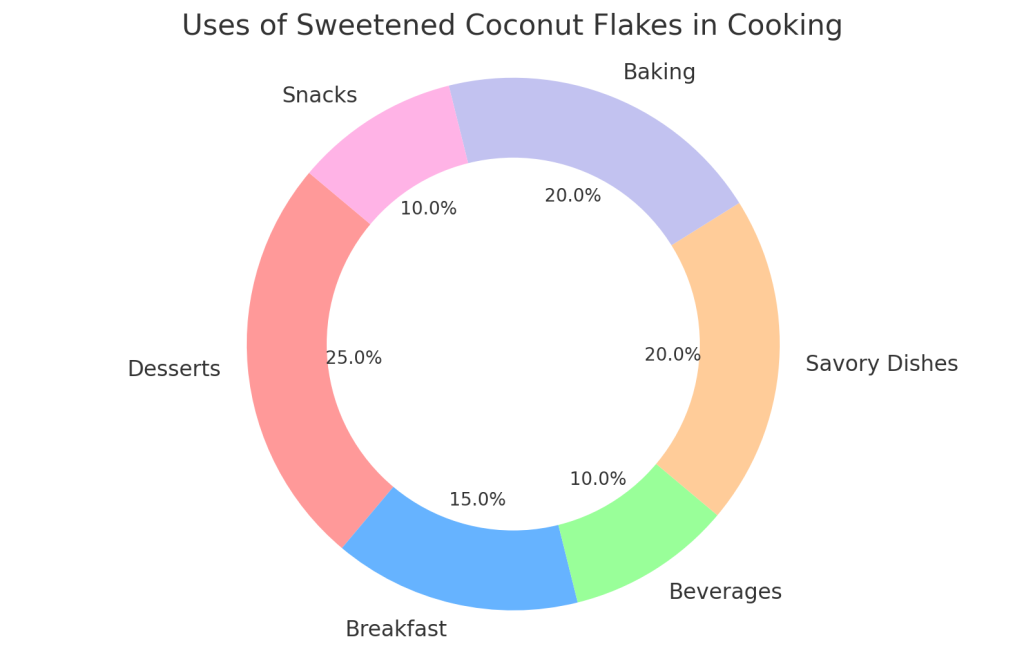Key Takeaways
| Aspect | Details |
|---|---|
| Sweetening Techniques | Explore methods to add sweetness to coconut flakes |
| Recipe Integration | Learn how to incorporate sweetened coconut flakes into various dishes |
| Preservation Tips | Understand how to store sweetened coconut flakes for longevity |
| Health Considerations | Discuss the health aspects of sweetening coconut flakes |
Coconuts, the seeds of the Cocos nucifera palm, have journeyed from their Indo-Malay origins to become a global staple in kitchens and cultures around the world. Their hard shell encases sweet water and rich meat, integral to traditions and daily life in many tropical regions. Revered in various cultures for their versatility in food, tools, and medicine, coconuts symbolize resilience and life.
Health and Nutritional Benefits of Coconuts
Coconuts are not just a tropical delight; they are a nutritional powerhouse. The meat of the coconut, from which flakes are derived, is packed with essential nutrients. These include Medium-Chain Triglycerides (MCTs), which provide a quick source of energy and aid in weight management. Coconuts also support heart health with specific fatty acids and are rich in electrolytes like potassium, making them perfect for hydration. Their lauric acid content offers antimicrobial properties, while the high fiber content aids digestion and promotes gut health.
Sweetening Coconut Flakes: A Step-by-Step Guide
Sweetening coconut flakes is a simple yet impactful way to enhance their flavor and integrate them into a variety of dishes, from desserts to breakfast items. Here’s how you can sweeten coconut flakes to add a tropical twist to your culinary creations:
- Choose Your Sweetener: Options range from natural sweeteners like honey or maple syrup to traditional granulated sugar. The choice depends on your taste preferences and dietary needs.
- Mixing Method: Combine the coconut flakes with your chosen sweetener in a bowl. Ensure even coating for consistent sweetness.
- Oven or Stovetop Toasting: Spread the sweetened flakes on a baking sheet and toast them in the oven, or use a skillet over low heat on the stovetop. This not only infuses the sweetness but also adds a delightful crunch.
- Cool and Store: Allow the sweetened flakes to cool before storing them in an airtight container.
Discover more about toasting coconut flakes for added flavor and texture.
Incorporating Sweetened Coconut Flakes in Recipes
Sweetened coconut flakes bring a unique flavor and richness to any dish, transforming ordinary recipes into exotic culinary experiences. Here are some ways to use them:
- As a Topping: Sprinkle over oatmeal, yogurt, or ice cream for added sweetness and texture.
- In Baked Goods: Incorporate into cookie dough, cake batter, or as a topping for muffins.
- In Smoothies and Beverages: Blend with fruits and liquids for a tropical twist.
Explore CoconutSphere’s recipe collection for more creative ideas involving coconut flakes.
Preserving Sweetened Coconut Flakes
Once sweetened, coconut flakes can last longer if stored properly. Place them in an airtight container and keep them in a cool, dry place. For extended shelf life, refrigerate or freeze them. Learn more about the shelf life of coconut flakes.
Health Considerations
While sweetening coconut flakes adds flavor, it’s important to consider the added sugars’ impact on overall health, especially for those monitoring sugar intake. Opting for natural sweeteners or reducing the quantity can be healthier alternatives.

Creative Ways to Use Sweetened Coconut Flakes
Sweetened coconut flakes can elevate a multitude of dishes, offering a balance of sweetness and tropical flair. Here are some innovative ways to incorporate them into your cooking:
- Tropical Desserts: Use them as a topping for tropical-themed desserts like pineapple upside-down cake or coconut cream pie.
- Breakfast Boost: Sprinkle over pancakes or waffles, paired with fresh fruits for a nutritious start.
- Savory Dishes: Incorporate into savory dishes like Thai curries or coconut shrimp for a hint of sweetness.
Explore more delicious recipes with coconut flakes to inspire your next kitchen adventure.
Rehydrating Coconut Flakes for Enhanced Flavor
Sometimes, coconut flakes might lose their moisture, leading to a less pronounced flavor. Rehydrating them can revive their texture and enhance their taste, especially when sweetened. Here’s a simple method to rehydrate coconut flakes:
- Warm Liquid: Soak the flakes in warm water or coconut milk for a few minutes.
- Drain and Dry: After they have softened, drain the liquid and pat the flakes dry.
- Sweeten and Use: Follow the sweetening process and use them as desired in your recipes.
For detailed guidance, check out how to rehydrate coconut flakes.
Sustainability and Ethical Considerations
In the world of coconuts, sustainability and ethical practices are paramount. When purchasing coconut products like flakes, consider opting for brands that prioritize sustainable farming practices and fair trade policies. This not only supports the environment but also the communities involved in coconut farming.
Exploring the World of Coconuts: From Cultivation to Kitchen
The journey of coconuts, from tropical groves to our kitchens, is a fascinating tale of nature’s ingenuity and human innovation. Each part of the coconut, from its water to its shell, has been utilized in diverse ways, enriching our lives with its versatility and benefits. At the heart of this journey are coconut flakes, a delightful byproduct that, when sweetened, add an exotic touch to various dishes.
The Global Journey of Coconuts
Coconuts have established themselves as a global phenomenon, celebrated for their refreshing water, flavorful meat, and myriad uses in cooking, medicine, and industry. Their ability to float across oceans has spread their presence globally, influencing various cultures and culinary traditions.
From Tree to Table: The Process of Making Coconut Flakes
- Harvesting: Mature coconuts are harvested from the Cocos nucifera palm trees.
- Dehusking and Opening: The outer husk is removed, and the hard shell is cracked open.
- Extracting the Meat: The rich coconut meat is carefully extracted from the shell.
- Shredding and Drying: The meat is then shredded and dried to form flakes.
The Versatility of Coconut Flakes in Culinary Traditions
Coconut flakes have become a staple in many culinary traditions, lending their unique flavor and texture to a variety of dishes. From being a key ingredient in tropical desserts to adding a crunch to savory dishes, their versatility is unparalleled.
Pairing Sweetened Coconut Flakes with Other Ingredients
Sweetened coconut flakes pair wonderfully with a range of ingredients, enhancing both sweet and savory dishes. Here are some pairing ideas:
- Fruits: Complement the sweetness of the flakes with acidic fruits like pineapples and oranges.
- Spices: Pair with spices like cinnamon or nutmeg to add warmth to desserts.
- Nuts: Combine with nuts like almonds or pecans for a textured contrast in baked goods.
Innovations in Coconut Cuisine
The culinary world is constantly evolving, and coconut flakes are at the forefront of many innovative dishes. Chefs and home cooks alike are experimenting with sweetened coconut flakes, using them in everything from vegan desserts to health-conscious snacks.
At CoconutSphere, we celebrate the diverse ways in which this extraordinary fruit enhances our lives. From its health benefits to its culinary versatility, the coconut continues to surprise and delight us with each new discovery.

